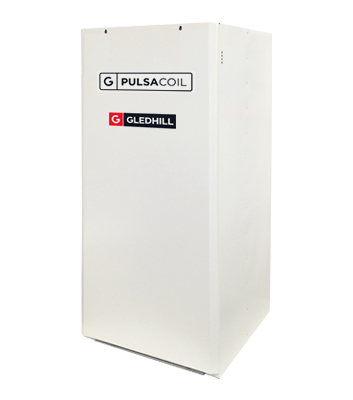You don't appear to provide provide a link - so perhaps you can you tell us ... does that use electricity to heat something (maybe water) and then later use that 'heated something' to heat cold water? If so, what is the point of that 2-stage process?
There are a number of reasons for using a thermal store.
You can, as already suggested, heat the water directly and store it. Such systems are common - lookup "unvented cylinder". These have the advantage (over the old vented hot water cylinder) of providing mains pressure* hot water. However, there are dangers with storing large volumes of hot water under pressure - hence they can only be installed as a complete package which includes multiple safety valves, and (IIRC) must be installed by a registered installer or something. They also are not suitable for use with uncontrolled heat sources such as wood burners - this creates a risk of producing superheated water, and a flash boiling explosion if the cylinder fails.
With a thermal store or heat bank** - I've never ever heard them referred to as instantaneous water heaters - the stored hot water is not under pressure. Unless you block off the vents then it's impossible to create such an "explosion" risk, you could boil the water in the store but you could not create pressurised water or steam. By having the second stage, you can get mains pressure* DHW without all the dangers (and mitigation requirements) of storing it under pressure.
One of those mitigation measures is a temperature & pressure relief valve that will dump hot water if the primary temperature or pressure controls fail. The rules on that safety vent pipe mean that many locations are not suitable to install an unvented cylinder.
Where thermal stores really win is when you want to combine multiple energy sources and sinks - especially if one of them is something like wood burner. It provides a neutral pressure point where flows in different circuits don't interfere with each other - so (for example) the (variable) flow round the central heating is decoupled from the thermo-syphon through the wood burner, and both are decoupled from the DHW.
Even without such multiple sources, they are good for providing "copious" DHW flow rates for DHW while also decoupling the variable flow rate central heating from the 20th century*** gas boilers we are still stuck with. Don't recall specific numbers, but DHW capacities of 100kW are not uncommon for heat banks.
I put one in the flat specifically for that reason, AND to allow the use of an immersion heater as a backup for when the boiler breaks down. It allows the immersion heater to provide both DHW and heating as long as you don't go too overboard on usage.
EDIT: You may well, correctly, assume that I rather like thermal stores. However I can't help thinking that hard-work has been at the cool aid as our friends across the pond like to say.
* Well they actually have to have a pressure control valve to limit the working pressure, so in high pressure areas it's not actually "mains" pressure.
** Historically, "thermal store" tended to mean a passive system with a heat exchanger coil for heating the DHW, while "heat bank" tended to mean an active system where the hot water is pumped round one side of a Plate Heat Exchanger (PHE) while the DHW passes through the other side of the PHE. Over time, the influence of marketing types has "somewhat blurred" those already "soft" definitions.
*** Manufacturers still don't allow variable flow rates through the boiler - especially not arbitrarily low flow rates - which are required to interface with an "all TRV" heating system and not have a bypass nobble the system efficiency.



